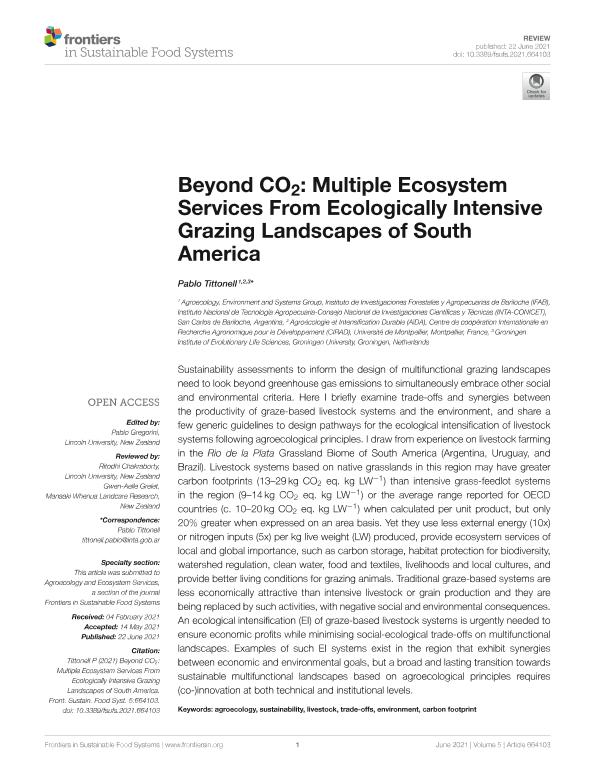Mostrar el registro sencillo del ítem
dc.contributor.author
Tittonell, Pablo

dc.date.available
2023-08-16T10:24:57Z
dc.date.issued
2021-06
dc.identifier.citation
Tittonell, Pablo; Beyond CO2: Multiple Ecosystem Services From Ecologically Intensive Grazing Landscapes of South America; Frontiers Media; Frontiers in Sustainable Food Systems; 5; 6-2021; 1-11
dc.identifier.issn
2571-581X
dc.identifier.uri
http://hdl.handle.net/11336/208450
dc.description.abstract
Sustainability assessments to inform the design of multifunctional grazing landscapes need to look beyond greenhouse gas emissions to simultaneously embrace other social and environmental criteria. Here I briefly examine trade-offs and synergies between the productivity of graze-based livestock systems and the environment, and share a few generic guidelines to design pathways for the ecological intensification of livestock systems following agroecological principles. I draw from experience on livestock farming in the Rio de la Plata Grassland Biome of South America (Argentina, Uruguay, and Brazil). Livestock systems based on native grasslands in this region may have greater carbon footprints (13–29 kg CO2 eq. kg LW−1) than intensive grass-feedlot systems in the region (9–14 kg CO2 eq. kg LW−1) or the average range reported for OECD countries (c. 10–20 kg CO2 eq. kg LW−1) when calculated per unit product, but only 20% greater when expressed on an area basis. Yet they use less external energy (10x) or nitrogen inputs (5x) per kg live weight (LW) produced, provide ecosystem services of local and global importance, such as carbon storage, habitat protection for biodiversity, watershed regulation, clean water, food and textiles, livelihoods and local cultures, and provide better living conditions for grazing animals. Traditional graze-based systems are less economically attractive than intensive livestock or grain production and they are being replaced by such activities, with negative social and environmental consequences. An ecological intensification (EI) of graze-based livestock systems is urgently needed to ensure economic profits while minimising social-ecological trade-offs on multifunctional landscapes. Examples of such EI systems exist in the region that exhibit synergies between economic and environmental goals, but a broad and lasting transition towards sustainable multifunctional landscapes based on agroecological principles requires (co-)innovation at both technical and institutional levels.
dc.format
application/pdf
dc.language.iso
eng
dc.publisher
Frontiers Media

dc.rights
info:eu-repo/semantics/openAccess
dc.rights.uri
https://creativecommons.org/licenses/by-nc-sa/2.5/ar/
dc.subject
AGROECOLOGY
dc.subject
CARBON FOOTPRINT
dc.subject
ENVIRONMENT
dc.subject
LIVESTOCK
dc.subject
SUSTAINABILITY
dc.subject
TRADE-OFFS
dc.subject.classification
Otras Ciencias Agrícolas

dc.subject.classification
Otras Ciencias Agrícolas

dc.subject.classification
CIENCIAS AGRÍCOLAS

dc.title
Beyond CO2: Multiple Ecosystem Services From Ecologically Intensive Grazing Landscapes of South America
dc.type
info:eu-repo/semantics/article
dc.type
info:ar-repo/semantics/artículo
dc.type
info:eu-repo/semantics/publishedVersion
dc.date.updated
2023-08-15T23:12:21Z
dc.journal.volume
5
dc.journal.pagination
1-11
dc.journal.pais
Suiza

dc.description.fil
Fil: Tittonell, Pablo. Instituto Nacional de Tecnología Agropecuaria. Centro Regional Patagonia Norte. Estación Experimental Agropecuaria San Carlos de Bariloche. Instituto de Investigaciones Forestales y Agropecuarias Bariloche. - Consejo Nacional de Investigaciones Científicas y Técnicas. Centro Científico Tecnológico Conicet - Patagonia Norte. Instituto de Investigaciones Forestales y Agropecuarias Bariloche; Argentina
dc.journal.title
Frontiers in Sustainable Food Systems
dc.relation.alternativeid
info:eu-repo/semantics/altIdentifier/doi/http://dx.doi.org/10.3389/fsufs.2021.664103
Archivos asociados
